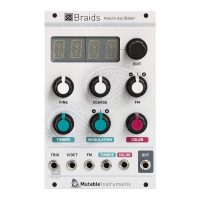_|_|_|_|_
This digital synthesis algorithm generates a smooth sequence of waveforms, transitioning
from a sine wave to a Dirac comb, as controlled by TIMBRE. The intermediary steps are
reminiscent of a single formant. Two such waveshapes are blended together, with the
detuning amount controlled by COLOR.
/|/| x3, -_-_ x3
Three sawtooth (or square) oscillators which can be individually tuned. COLOR and TIMBRE
control the relative frequency of the second and third oscillator with respect to the main
oscillator. These two controls are quantized to “snap” on musical intervals like octaves or
fifths.
RING
Three sine wave oscillators are ring-modulated together, and colored by a waveshaper. The
main oscillator frequency controls the frequency of the first sine wave, and TIMBRE and
COLOR control the relative frequency of the second and third sine waves.
/|/|/|/|
This model simulates a swarm of 7 sawtooth waves. TIMBRE controls their detuning, and
COLOR applies a high-pass filter to the resulting sound.
/|/|_|_|_
This model generates a sawtooth waveform, and sends it into a comb filter (tuned delay
line). The frequency of the delay line tracks the frequency of the sawtooth oscillator, with a
transposition controlled by the TIMBRE knob. COLOR selects the feedback amount and
polarity: at 12 o’clock, no feedback is applied. From 12 o’clock to 5 o’clock, positive feedback
is increasingly applied. From 12 o’clock to 7 o’clock, negative feedback is progressively
applied.
TOY*
This model traverses a space of timbres typical of (circuit-bent) electronic musical toys.
TIMBRE simulates an alteration of the toy’s clock rate, while COLOR creates glitches or
short-circuits on a converter or memory chip’s data lines.
ZLPF, ZPKF, ZBPF, ZHPF
This family of models directly synthesize in the time-domain the response of a low-pass,
peaking, band-pass or high-pass filter excited by classic analog waveforms. Rather than
synthesizing the waveform and filtering it (which is what a VA synthesizer would do), this
approach directly aims at building the filtered waveshape from scratch. This technique has
been used in the Casio CZ or the Roland D series, but is extended here to cover different
filter types and waveshapes. TIMBRE controls the cutoff frequency of the filter. COLOR
continuously modifies the waveshape, from saw to square to triangle.
VOSM
This model uses a combination of 3 oscillators arranged in a clever ring-modulation/hardsync
patch to emulate formant synthesis – a technique named VOSIM and described by Kaegi
and Tempelaars. COLOR and TIMBRE control the relative frequencies of the two formants.

